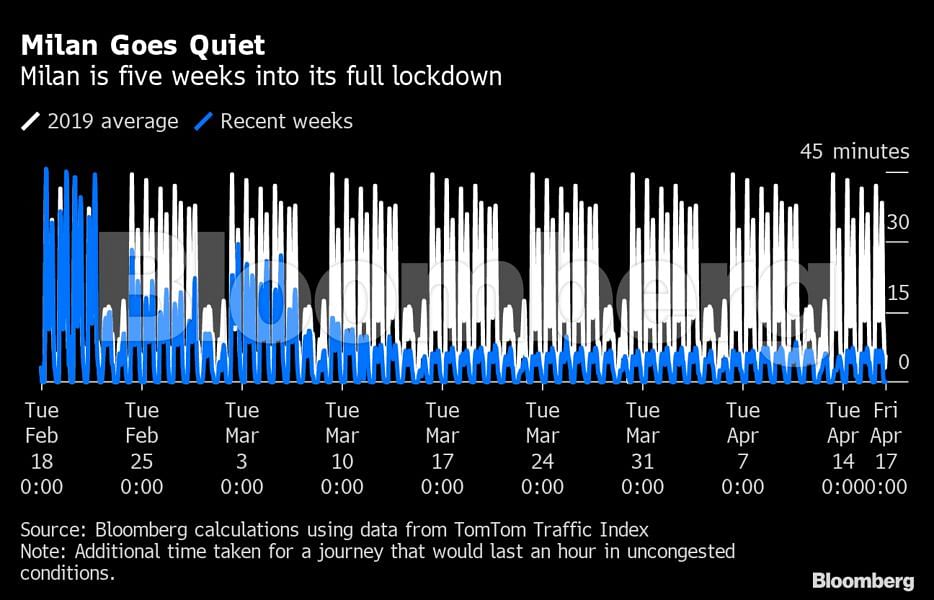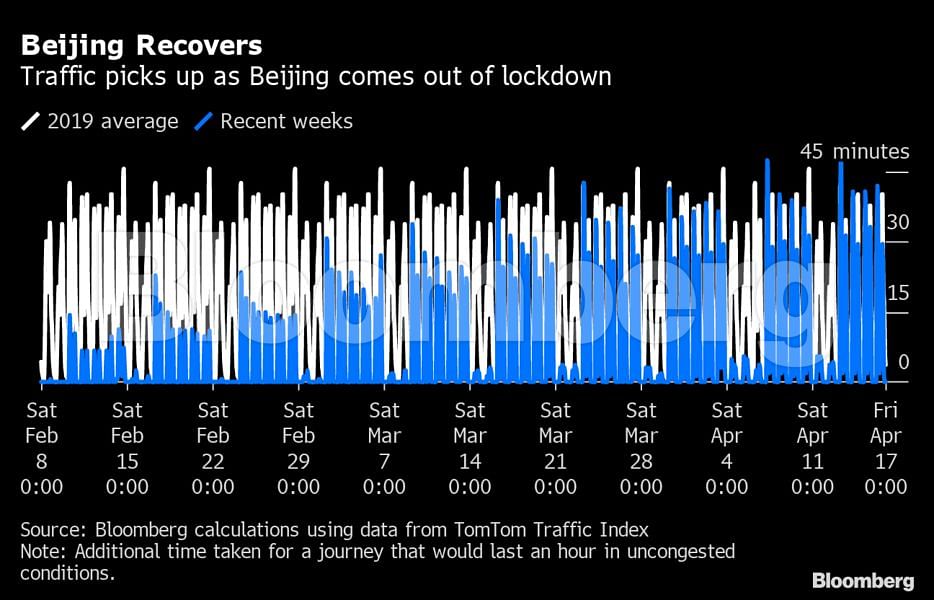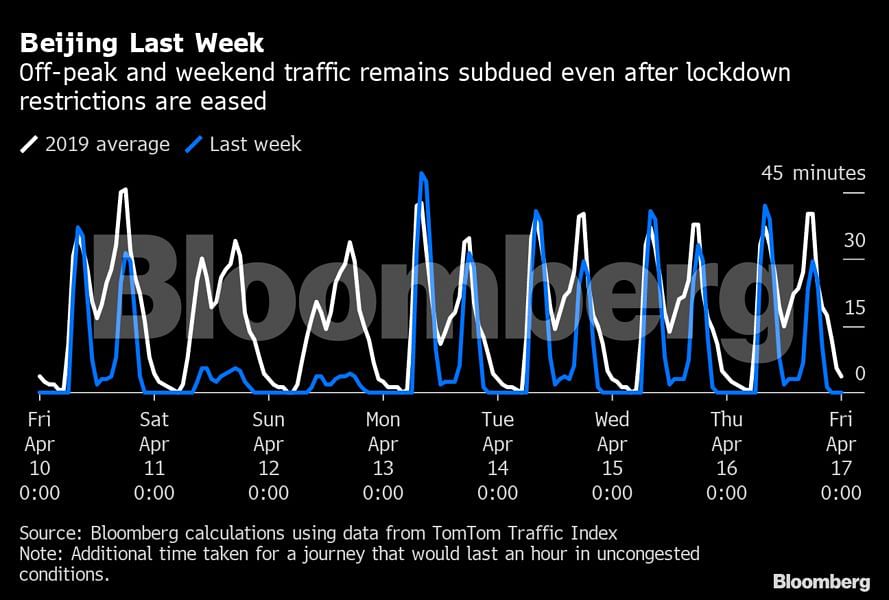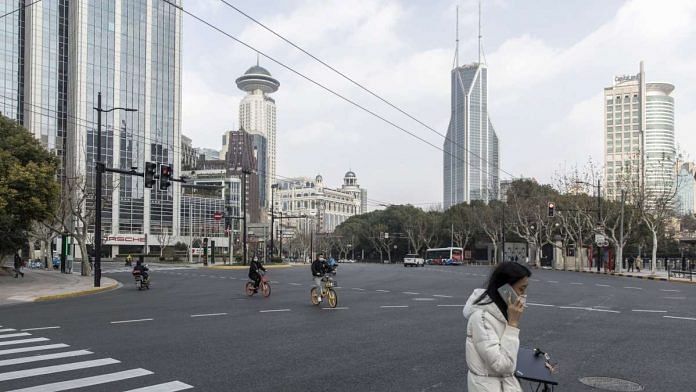Easter weekend? What Easter weekend? I spent the entire time following the twists and turns of the extraordinary attempt by oil producers to cobble together the biggest output cut in history, only to see the price fall when commodity markets opened on Monday. Lockdown? I was glued to my computer all weekend and wouldn’t have noticed if all restrictions had been removed. Of course, they weren’t, and that got me thinking about just how our lives have come to a screeching halt.
Enjoy the stillness. I live under a flight path into one of London’s major airports, so the grounding of planes does have its upside. As do the quieter roads when I take my bike out for my morning “commute” — halfway to the office and back each morning.
Cities have become noticeably quieter with far fewer cars out on the roads. Restrictions came later to London than many other European towns, and traffic flows only started to wane in the second half of March. The impact on congestion shows, but it’s been significantly less than in Milan in northern Italy, for instance. Last year drivers in London, like their counterparts in Italy, could expect a peak-time journey to take about 75% longer than the same trip on empty roads — an additional 45 minutes on a one-hour trip. Now that same “one-hour drive” in London takes around one hour and 10 minutes.
In northern Italy, where restrictions were introduced during the second half of February, peak-hour delays have been reduced to around 5 minutes from as much as 45 minutes on a one-hour journey.

To examine how driving has slumped and how, in a few places, it’s picking up again, I used figures from the TomTom Traffic Index to make these charts. The data show how much longer journeys in selected cities take during each hour of the week than they would on uncongested roads. The original numbers are in the form of a percentage increase over all journeys. I have standardized them to show how many more minutes drivers could expect to spend in their cars for a journey that would take an hour on empty streets.
Congestion patterns in the Middle East show a similar picture to those in Europe. It’s a region that has received much less coverage of the virus’s impact, except for Iran where the outbreak appears particularly severe. But here, too, streets have gone quiet. Kuwait City has seen traffic congestion fall to almost zero, with stringent restrictions in place for nearly two months and showing no sign of being lifted.
In the U.S., urban traffic congestion also tumbled during the first half of March, as Americans joined the Great Silence. Here, the additional time spent in the car during peak hours has fallen by around 90% compared with the same day of the week last year.
As the West stays home, Chinese cities are coming out of lockdown. But a careful look at traffic congestion data shows that things are far from back to normal, even in cities where restrictions were eased weeks ago. The experiences there are illustrative of what the rest of us may face when our own governments start to ease the strictest confinement measures.
Beijing and other Chinese cities provide the clearest data on how a place recovers from lockdown imposed to fight the Covid-19 virus. The chart below shows that journey times have risen slowly over recent weeks, as more and more traffic returns to the city’s roads. By last week, it looks as though gridlock had returned to Beijing, with journeys taking just as long as they did on average last year.

But that picture is deceptive and we need to look a little closer to see why.
Pulling out the data for the most recent week, it becomes clear that normalcy isn’t fully back in every corner of life in Beijing. While congestion has indeed returned during the morning and evening rush hours, the volume of traffic on the roads at other times of the weekday and weekends remains at extremely low levels. People may be traveling as normal to get to and from work, but driving for social purposes — to get to the mall, or cinema complex, or museum, or to visit family or nearby parks — remains at a very low level. Journeys outside of rush hour are still taken on almost empty roads.

Of course, I couldn’t finish without saying a few words about oil. The impact of the enforced stay-at-home policies on U.S. gasoline use has been dramatic, to put it mildly. The Energy Information Administration reported four-week average demand in the period to April 10 at just 6.4 million barrels a day — its lowest level in data going back to 1991. The figure is down by nearly a third, or 3 million barrels a day, in the past month.
Judging by the picture emerging from Beijing, even if some U.S. cities and states begin to ease shelter-in-place orders and other travel restrictions, demand may not rebound quickly if citizens remain wary of travelling too far and gathering in crowded public spaces. Commuters will be the first to feel the tedium of increasing traffic as restrictions are eased. Those driving for pleasure — at least, those who venture forth — may experience empty roads for a while longer.
Also read: 5 lessons Covid-19 teaches us about fighting climate change






